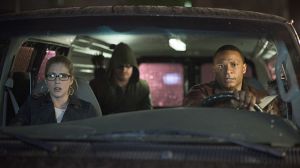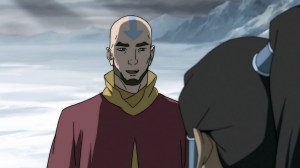Six different stories. One dead world. Tales of the Walking Dead is AMC’s episodic anthology series from The Walking Dead Universe, consisting of six original one-hour standalone episodes focused on new and established characters within the walker apocalypse. Each episode has its own distinct tone and point of view — but the stakes are high in each story, pushing new, indelible characters with relentless, life-threatening choices and situations. We get to see the apocalypse through different eyes, discovering more worlds, mythos, and mysteries of the Walking Dead. Directed by Haifaa al-Mansour and written by Ahmadu Garba, Season 1 Episode 4 is Amy/Dr. Everett’s story.
Videos by ComicBook.com
The Dead Sector
Life flourishes. As the planet thrives post-apocalypse, naturalist Dr. Chauncey Everett (Anthony Edwards) narrates a nature documentary recorded with drones and trail cameras.
“What we are witnessing is nature’s great reclamation effort in our current geographical epoch. Within this territory, demarcated by a 40-foot deep, 200-meter wide man-made trench spanning hundreds of miles, the revitalization of biodiversity rivals the most diverse ecosystems of the Holocene. Uniquely driving this resurgence is one of the world’s apex predators. A hunter so capable that it can hunt alone or in packs. So unrelenting that it doesn’t sleep. So lethal, primitive man ran from its numbers, abandoning it to this remote and barren wilderness known as the Dead Sector.
“Speciation of the Homo sapiens has reduced the human being to prey and elevated the Homo mortuus — a term I have coined for the dead — to the top of the food chain. I’ve spent years tracking and trying to understand the complex migration patterns of the Homo mortuus, which are highly manipulated by the presence of sound, signaling potential prey.”
The Food Chain
Everett’s studies focus on three specific specimens: Specimen Sunflower, a walker that seems to posses an acute auditory sense,always one of the first to react to a disturbance; Specimen Gamma, one of Everett’s original specimens that has endured various attacks by both human and animal predators; and Specimen 21, a male walker who “has illuminated my understanding of the Homo mortuus more than any other subject.”
The Homo mortuus walk without purpose, tearing apart any prey in their path as they move in a horde.
“They say there’s power in numbers, and that is especially true for the Homo mortuus, who travel in large herds, sometimes numbering thousands. The natural food chain can be very unforgiving, even for newborns. But that’s the beauty of nature in its purest form. There’s no right or wrong. There’s just the excruciating process of life,” Everett narrates.
Everett’s drone camera captures a pile of decapitated Homo mortuus. This was not Nature, but Man.
Wearing a jacket made of Homo mortuusskin — walker flesh — allows Everett to get close to the herd, camouflaging his scent from the dead.He documents the greatest threat to Homo mortuus: skull hunters.
The doctor records his findings: “They breach the sector to poach heads as trophies. Beyond the trench, mortuus skulls are used as scare propaganda. This practice is vile and barbaric. There is no shortage to human depravity.”
Safety in Numbers
In the woods nearby, a young woman runs for her life. In one hand is a blade prosthetic, and the other, a severed Homo mortuus head. She is Amy (Poppy Liu).
Surrounded by walkers, she flags down the drone and calls for help. She drives her weaponized arm through the brains of the Homo mortuus as Everett, wielding only a pair of binoculars, watches from afar. He interferes only when Amy’s blade strikes the man-made device around Specimen 21’s neck. Before she can kill it, Everett shoves the Homo mortuus aside and escorts its prey to safety.
She trails behind Everett, asking and then begging for help. “You shouldn’t be here,” Everett scolds. “Are you a mule?” She’s lost. An attack separated her from her group and she’s been on her own for three or five days. She’s suffering from headache and severe stomach pain, like “someone’s punching me from the inside out.” But she’s not bit, she assures him, and she’s not a thief.
“I don’t work with humans,” Everett says plainly, leaving Amy behind to fend for herself.
One and the Same
Amy trails Everett to a ranger’s station. Her ruckus has drawn the attention of a pack of Homo mortuus. “Look, I get that you don’t want to help, but if I were in your shoes, I would,” she shouts up at the treehouse accessible only by rope ladder. “What’s the point of going through all that effort to save my life just to leave me out here as bait, huh?”
One-handed, Amy manages to scramble up the ladder and collapses at Everett’s door. “You know, maybe this is the end. Maybe I just die here on your doorstep,” she yells, exhausted. “If so, just be careful when you open the door. Because I’ll probably have turned by then. Sorry if I take a chunk out of your neck. I apologize in advance.”Though not in his nature, Everett opens the door.
Later, Everett cooks up a cure to Amy’s ailment: a concoction of charcoal water, spiraea, ginger, turmeric, and Frankincense oil. She’s been surviving on handfuls of nightshade berries, which can be poisonous when not fully ripe. “You’ve been slowly killing yourself for the last few days, so you can drink, or die,” he explains, simply. “It’s up to you.”
24 hours pass as Amy recovers. Inside the ranger’s station converted into a scientist’s lab, Everett fiddles with a telemetry antenna for data collection and research.
She looks around, picking up a skull. “Homo erectus, right? On a scavenging run, we found on old school, grabbed some books… Biology, chemistry, algebra. My favorite thing is the bird section in the biology book.”
Annoyed and trying to concentrate, Everett speaks only when Amy refers to the reanimated undead as “chompers.”
“That’s what we call them,” Amy explains. He tells her he found Homo mortuus bodies stacked up and missing heads. “Are you a skull hunter?”
She swears she doesn’t hunt skulls. “I’m with a group trying to resettle the Dead Sector,” she explains. “The skull hunters help us get past the trench.”
“Humans don’t belong here,” Everett responds. “That’s the point of the trench.”
“You ever cross over? You ever seen how bad it is on the other side?” Amy retorts. “Yeah, it’s crazy that we just abandoned so much up to them.”
“That’s the problem with Homo sapiens. All we do is take, take, take, until there’s nothing left. And then once nature corrects the damage, we go back and do it all over again,” Everett tells her.
She’s confused. “Are you arguing for chompers or for nature?”
“They’re one and the same now,” he answers.
The Basis of Life
It’s time for Amy to leave. She got turned around and doesn’t know her way back. Curious, she asks about the pictures of Specimen 21 decorating the walls. “Did you know him? Is that why you’re here?”
He asks her, respectfully but more forcefully, to please leave. “It’s just a little weird that you’re stalking some random chomper,” she points out, innocently.
“I am studying the Homo mortuus,” Everett explains, almost defensively. “Everything from their behavior psychology to migration patterns. Specimen 21 is a subject. That’s all.”
“They don’t do anything other than walk around and try to kill us. There, study done.”
Everett scoffs. “You know, you can ascertain a lot of information just by observing. For example, I witnessed Specimen 21 killing a wild dog, and instead of consuming his prey, he left it behind for the trailing herd. I found his actions to be a selfless display of generosity.”
Or, Amy counters, “Maybe he just sensed some other prey.”
“Another simplification. He’s done it twice in a row, and my analytic mind questions why. Instinctively, he’s a protector, making sure the rest of the herd is taken care of.”
Amy is onto him. “Yeah, seems like someone that you knew.”
“You’re fixated on the wrong thing. This is about the science,” Everett tells her. “Science is how we survive, or don’t. Science is the basis of life on this planet. Science over everything.”
She’s not buying it. “Doesn’t really sound like science to me,” she says with the attitude of an unaffected high school student challenging her teacher. “Sounds like some weird personal quest.”
“Your interpretation of my actions is not relevant,” Everett responds.
He lost track of Specimen 21 yesterday, after Amy damaged his transmitter. “I need to find him, retag him, and get him back to the herd before something happens to him.”
“So when you were saving me yesterday,” Amy asks, “were you really saving him? Because that’s really messed up.”
It’s time to go.She asks him to point her to the direction of the Chattahoochee. Her people were heading east of there. Everett complies, but tells her, “You should know you’re wasting your time trying to settle this place. I hope you realize that before nature has its final say.”
Specimen Friend
In the woods, Amy spots Specimen 21. She marks trees as she trails the subject. That night, Everett comes across a mauled Homo mortuus, its arm severed from its halved body. He collects the arm, wraps it in plastic, and returns to his ranger’s station to find Amy waiting for him. She proudly reports she found his “specimen friend,” and she’ll happily tell him where Specimen 21 is if she helps him find her group.
He reminds her that the settlers don’t want to live here.
“My people are kind, okay? We’re not trying to hurt anyone,” Amy assures him. “We look out for each other, and at end of the day, we’re just trying to find a place to call our home that can sustain us. I know you’ve been out here on your own for a really long time, so maybe you don’t get it, but… my community means everything to me.”
They’ll leave at first light. Together.
The Marvel of Nature
The next day, Amy and Everett are on Specimen 21’s trail using the tree markings. She asks about his research. “What are you getting out of all this?”
He shows her life: footage he’s recorded of plant and animal life that thrives in contrast to the dead world. Animals that escaped zoos have reclaimed the land. Awed, Amy tells him, “It’s like a different world.”
Explaining the marvel of nature, Everett says it’s because humans don’t exist in the Dead Sector.
“I was part of a research group studying the environment since the shift. Unfortunately, disagreements fractured our group. We gave up our lives for this study. I have to honor that,” Everett explains. “There’s a lot more to learn.”
“So, in a way,” Amy replies, “you’re doing this for your own community.”
“You’re determined to filter everything through your narrow perspective. What my team and I understood is that Homo mortuus are part of nature.”
“Like 21 and that chomper surrounded by caution tape?”
The severed and decaying walker is one Everett has been studying for over seven years. “My job is to observe, collect data, analyze it, and never interfere.”
Amy points out he interfered when she almost killed his specimen.
“I had no choice but to protect my research,” he explains.
Amy replies, “You know, you think you’re a lot more objective, but you’re way more sentimental than you think.” For Everett, “Sentiment is a hindrance.”
“You know, I’ve lost so many people. At night, sometimes I cry myself to sleep just thinking about them, but the memories… They’re all that’s left,” she tells him. “If I didn’t have those memories, I would have given up a long time ago. Human connection is all we have.
Not convinced, Everett tells her, “Well, you should connect on the other side. Not here.”
Objective as Possible
Everett reveals his jacket made of Homo mortuus skin was given to him by a friend he used to research with. The dead flesh protects him from being detected by the herd. She once read a poem about how humans wear masks. The jacket reminds her of that. He offers to let her borrow from his extensive collection of poetry books.
She asks about the science. “What happens to chompers if we all die? I mean, they don’t reproduce, so that means they’ll eventually rot out, and that’s not sustainable for a species.”
“That’s an astute observation. It’s clearly a paradox,” Everett answers.
“However, I will say this. Homo mortuus will exist as long as humans are around, which puts our survival in question.”
They come across a moment of beauty: a colorful Victoria crowned pigeon. Once on the verge of extinction, the bird is beautiful. “You’re alive,” Amy says. “You’re right here.” Amy’s marveling turns to heartbreak when the bird flies away.
“We may never agree, but I can tell you care about nature,” Everett says, offering her a job as his assistant to aid with his research. “I won’t live forever. You could take over the work when I’m gone.”
“And live like a recluse?”
“You would be surrounded by all of this splendor. Your personal Eden.”
She instead invites him to come live with her people.
“And aid in the destruction of nature all over again?” he asks.
It doesn’t have to be that way again. “We can learn from the past and build a new type of settlement,” she says.
“I’ve lost my faith in humans.”
She says he’s scared. “You shitting on people is just an excuse not to do anything,” she figures. “You want to fix things? Start with my group. I promise you, every single one of us will listen.”
He explains it’s not that simple. “Maybe your group does do the right thing, but what about the generation after?”
She tells him, “We can respect the science and care for people at the same time. One without the other is just stupid. So, don’t tell me science over everything, because that’s just a sorry excuse!”
Everett softens. “You think I’m callous, that I don’t care about people. After I lost my team, I wandered around for two years until I found the ranger’s station. I climbed up, knocked on the door, it opened, and the face that greeted me stirred up emotions I never even know I had.”
It was a former colleague. Dr. Moseley. “When our research team fell out, he was the first one to go off on his own. I never thought he’d survive, and there he was, continuing his work. I’d given up hope. I was ready to die. Finding him was like a rebirth.”
Everett reveals Dr. Moseley succumbed to cancer.
“He made me promise to not kill him, but to study him. Dr. Moseley is Specimen 21.”
“So, you do know him. Why did you say you didn’t?” Amy asks.
“It’s imperative that with one study, you remain as objective as possible.”
A Lot to Learn
Amy and Dr. Everett come across a wired fence. It’s her people. On the other side of it, Everett sees a beheaded Homo mortuus. “The skull hunters would only help us cross under the condition that we helped them collect heads,” Amy explains.
In the distance, they hear the settlers screaming. Everett holds her back as walkers tear apart her friends. “You can’t interfere,” he says. “Let nature take its course. We’re part of the food chain now.”
Sobbing, Amy breaks free and fights off the chompers. She sends Specimen 21 tumbling over a hill and into the river below. Everett begs Amy to help him retrieve 21.
“You left my friends to die!”
He apologizes for his selfishness. He pleads for her help. “Help me save my subject. I’ll do anything. I’ll be in your group. I’ll live in your community.”
As cold as he’s been, Amy asks: “What happened to don’t interfere, huh?”
Everett tries to save 21 alone, but Amy warns the doctor he’ll freeze if he wades into the water. Using a rope, Everett throws it and misses. He tries again, lassoing 21’s arm. Before he can reel in his catch, a gator drags its prey beneath the surface. As Everett mourns the loss of 21, his former colleague torn apart by teeth, Amy angrily tears into Everett’s hypocrisy.
“My friends died because of you, then you almost get us both killed because you were trying to save a chomper?! You don’t believe in anything! You make your own rules to fit your agenda, but you didn’t lift a finger! You just watched as we got eaten!”
“I didn’t do anything because your friends are already dead. You all are,” Everett explains, pointing to vultures overhead. “They sense death. They’re waiting to eat.”
Amy fears for the settlers at their camp. Everett explains the Homo mortuus she killed, and Specimen 21, were likely on their way to join the herd when they stumbled upon her friend. “Homo mortuus packs join bigger packs, and so on, until they form a big mass. Your settlement is in the pathway of their migration route. None of your people are gonna make it out.”
She wants to warn them, but it’s too late. “If you go back there,” Everett tells her, “you will die.”
“You knew my people were in danger all along, and you didn’t say anything!”
“I did say something! I told you that this land wasn’t safe,” he retorts. “You didn’t listen.”
“And so you’re just gonna let them die?”
“No,” Everett reminds her. “Nature is.” He again asks her to study the Dead Sector with him. “There is still a lot to learn. If you go back to try to save them, you will meet their fate.”
Amy leaves Everett alone. “I would rather die than end up like you.”
Nature Is What We See
Later, Everett explores the remains of the settler camp. The humans have died, preyed upon by Homo mortuus. Everett records video log coded 4306 with his observations.
“As I lay awake, Emily Dickinson’s poem replayed in my head. Over and over again. ‘Nature is what we see. The Hill. The Afternoon. Squirrel. Eclipse. The bumble bee. Nature is Heaven…’“
Everett does not interfere. The settlers are gone. Homo mortuus remains.
“‘Nature is what we hear. The Bobolink. The Sea. The Cricket. Nay. Nature is Harmony. Nature is what we know. Yet have no art to say…’“
Everett sees her: Amy. Dead. Turned. Another specimen to study. Science is the basis of life.
“…’So impotent Our Wisdom is…to her Simplicity.’”
End of episode.
New episodes of Tales of the Walking Dead premiere Sundays on AMC and AMC+.
Follow @CameronBonomolo and @NewsOfTheDead on Twitter for TWD Universe coverage all season long.








